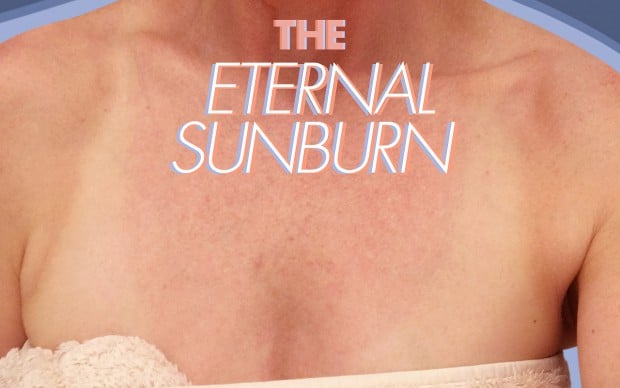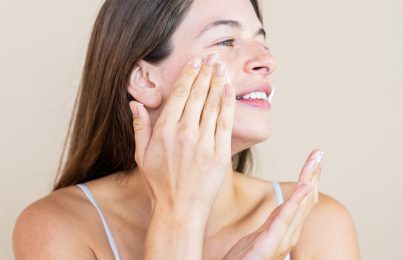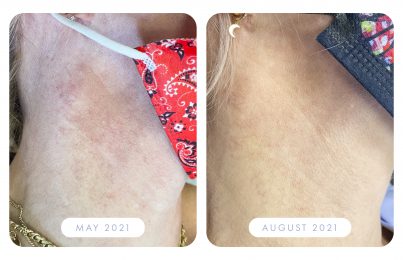Updated 09/19/22. This is a picture of my chest that I took a few years ago. I’m sure you’re thinking, “Renée has been an esthetician for over 30 years, yet she got a sunburn?” Not quite. The truth is that I haven’t had a sunburn in many, many years. I’m very conscious of sun exposure, which is why I never go outside without layering on sunscreen or wearing sun-protective clothing. So, what’s this all about, then?
The answer might surprise you. What you’re seeing isn’t a current sunburn; rather, it’s damage from a really bad sunburn I had when I was 19 years old. This is nothing but a “flare-up” that appears every now and then when I get overheated in the shower. In other words, it’s lingering sun damage… In this post, I’ll talk about sun damage on the neck and chest and what you can do to address it!
The Sun Damage on My Chest
First, I want to talk about why it looks like I’m sunburnt even though I’m not.
When skin gets sunburnt, capillaries experience an increase in blood flow. When I got badly sunburnt all those years ago, it actually weakened my capillary walls. With age (I just celebrated my 53rd birthday), my capillaries will continue to weaken due to a loss of collagen and the deterioration of skin structure. Add in the fact that the sunburn happened on my chest, which is an area where the skin is naturally thin, and sun damage becomes easily visible. All of this combined causes my chest redness to “flare up” from time to time.
For many people, years of continuous sun exposure give them chronic redness and discoloration. Mine only flares up when I’m particularly stressed because my blood pressure increases. This time, though, it was even more apparent because it was combined with the heat from a shower. (Heat causes capillaries to expand, which increases blood flow and exacerbates the appearance of redness.) Even though these “flare-ups” usually go away after 30 minutes or so, I’m always amazed that you can still see my exact bathing suit lines. It’s crazy, isn’t it?
It just goes to show how one sunburn, even if it happens at a young age, can come back as visible sun damage years later. To all my young readers, take heed!
How Can I Improve the Appearance of Sun Damage on My Neck and Chest?
If you have sun damage on your neck and chest, don’t despair. There are a variety of ways you can address this.
1. Use an At-Home Chemical Peel
Regular exfoliation can majorly improve the appearance of sun damage since it removes rough, pigmented cells and boosts cellular turnover. Translation? It smooths the skin and, over time, helps fade discoloration.
You can use a product like the Dual Enzyme Softening Peel once a week. Unlike exfoliating acids, enzymes are activated by water and work more slowly to digest cellular buildup. I recommend applying this product to clean, damp skin and leaving it on for 15-20 minutes. The natural enzymes from papaya and pineapple will go to work!
On top of at-home exfoliation, I recommend getting professional chemical peels to expedite results (more on that in a minute).
I also always recommend incorporating an exfoliating acid serum into your skincare routine a few nights a week. These are great for encouraging continual cellular turnover, which helps the skin look bright and more even-toned. Take the Pro Results Power Serum for instance. I formulated it specifically for sun-damaged skin. It contains a powerful blend of 20% lactic, glycolic, and mandelic acids. Together, they help minimize the appearance of discoloration and reduce visible texture.
2. Use Retinol
Retinol is one of the most well-researched and tried-and-true ingredients to use for signs of aging and sun damage. I have a long history of working with retinol and retinoids, and I always recommend the Advanced Resurfacing Serum to my clients. When used regularly, it can improve the appearance of sun-damaged skin.
You’ve probably heard that using retinol during the day is a huge no-no because it makes your skin more sensitive to the sun. This photosensitivity is actually a cumulative effect that occurs due to the fact that retinol increases cell turnover. This means that fresh, new cells are constantly being brought to the surface. These cells are more vulnerable to sun damage than dry, dead skin cells. This is why it’s so important to wear sunscreen every day when you’re using a retinol product.
Personally, I wear Weightless Protection SPF 30 every single day. Since I use retinol on my neck and chest, I’ll squeeze out a generous separate application for those areas. Trust me—this combination of retinol and SPF is a surefire way to combat signs of sun damage on the neck and chest!
3. Use an Antioxidant Serum
Without a doubt, antioxidants, such as vitamin C, can improve the look of discoloration and create a more even-toned complexion. Vitamin C not only works to suppress melanin activity, but it can also prevent redness by keeping capillary walls strong. It can even help rebuild collagen, which is essential when caring for sun-damaged skin.
Every morning, I apply the Vitamin C&E Treatment to my face, neck, and chest before sunscreen. Then, a few nights a week, I’ll use the Firm + Repair Overnight Serum on those areas as well. It contains algae extracts and peptides, which help support skin structure and encourage firmness. It makes for some good beauty sleep!
4. Use Neck Cream
If you’re using neck cream, you’re providing your skin with much-needed moisture. You’re also providing it with firming ingredients that can improve the appearance of the thin, damage-prone skin on the neck and décolleté region.
I have all of my clients use the Intensive Firming Neck Creme every night (I recommend applying it to both your neck and chest!). It’s formulated with peptides, which can help firm the skin, algae extract, which can help de-puff, and apple fruit extract, which can help promote cellular renewal. It’s the perfect product for giving your sun-damaged neck and chest some serious TLC!
5. Wear Sunscreen Every Day
I know I already mentioned the importance of wearing daily sunscreen, but it bears repeating. No matter how much sun damage you’ve already incurred, it’s never too late to protect yourself from more. In fact, it’s far easier and less expensive to protect yourself from damage than it is to address it after the fact.
Apply a generous amount of sunscreen to your face, neck, and chest every day. And don’t make the mistake of applying sunscreen to your face and then just bringing whatever is left over down to your neck and chest. These areas require complete, separate applications. (This is how much sunscreen you should really be applying.) As I said before, I like using Weightless Protection SPF 30. It’s a lightweight sunscreen that can work for all skin types.
6. Eat Your Antioxidants
Along with topical antioxidants, like those from the aforementioned serums, I also recommend eating antioxidant-rich foods. These nourish our bodies and help slow down visible signs of aging. Check out the 10 best antioxidant-rich foods to eat for your skin!
On top of eating antioxidant-rich foods, I also take an antioxidant supplement every day—vitamin C with bioflavonoids. I do this to help keep my capillaries as strong as possible. It can also be beneficial for those with rosacea. Read more about this supplement and its skin benefits.
7. Get a Professional Chemical Peel
As we all know, sunburns can lead to changes in skin color and texture. While a consistent and well-rounded skincare routine can make a major difference, sometimes, it helps to turn to an expert for a professional chemical peel. These can boost the results of your at-home exfoliation to minimize the appearance of bumps, crepey texture, and discoloration.
One thing you should know is that not all professional chemical peels are the same. They come in various strengths, which is why it’s important to consult a trusted professional to decide which one is best for you. It’s also important to know that chemical peels are more effective when completed in the fall and winter months, as the skin will not be exposed to as much sun. Find out the best chemical peel for you, according to your skin type.
8. Get IPL Laser Treatments
Another in-office treatment that can help address sun damage is IPL. This stands for Intense Pulsed Light (it’s also referred to as photorejuvenation or photo facials). These treatments are extremely effective for addressing discoloration and may even help improve capillary damage. IPL treatments use powerful flashes of light to emit energy that can penetrate below the skin’s surface. The heat breaks down pigment into tiny particles, which either rise to the surface as tiny scabs that fall off within a week or get carried away via the body’s lymphatic system.
I get IPL treatments a few times a year to address my Poikiloderma. This is a condition in which blood vessels and brown discoloration appear on the sides of the neck just below the ear in big patches. As for the sun damage on my chest, it doesn’t flare up too often. It’s typically not something I pay much attention to, but writing this post reminds me that I really need to take better care of it!
Note: while IPL can improve redness, vascular lasers may deliver better results. A fractionated laser treatment known as Fraxel triggers the skin’s wound-healing response to stimulate collagen. The downside is that there is more healing time involved.
The Bottom Line
There you have it. These are eight effective ways to address sun damage on the neck and chest. I hope you found this post helpful in your own quest to address sun damage!
Before you move on, I have one more thing I want to talk about, and that’s skin cancer screenings. Regardless of how much time you spend in the sun, EVERYONE should get a yearly skin cancer screening with a dermatologist. I had my own skin cancer scare, so I know how important it is to keep tabs on this. It’s serious business.
Next, read up on tech neck and expert-approved ways to get rid of it.
Celebrity Esthetician & Skincare Expert
As an esthetician trained in cosmetic chemistry, Renée Rouleau has spent 30 years researching skin, educating her audience, and building an award-winning line of products. Her hands-on experience as an esthetician and trusted skin care expert has created a real-world solution — products that are formulated for nine different types of skin so your face will get exactly what it needs to look and feel its best. Trusted by celebrities, editors, bloggers, and skincare obsessives around the globe, her vast real-world knowledge and constant research are why Marie Claire calls her “the most passionate skin practitioner we know.”




Comments:
I just want to say how much I appreciate this blog post and how you operate. I went on the internet to find some simple information about a problem I’ve been having, and this came up! You are so direct, informative, and helpful! Are the greatest is that you have no ads to scroll past! You do pitch the product you helped develop but also provide a number or treatment options that fit an array of budgets. This was the most pleasant google search I’ve made in a long time, thank you.
Posted By: Shasta Werthman |
What a wonderful blog! Love the educating you are doing and I learned something new to share with my clients! Amazing delivery 🙌🏻
Posted By: Lorean Dillard |
Thank you so much!
Posted By: Renée Rouleau |
I have something similar to this. It is redder than usual right now. Im sure its from sun damage from years gone by. Ive tried everything and nothing seems to help. It does seem like high blood pressure makes it worse If you are a dermatologist and still have it. Then I feel there is no hope to get rid of it.
Posted By: Shan |
Hi! While it’s not always possible to get rid of old sun damage, following the steps in this post can help reduce it.
Posted By: Renée Rouleau |
Have You ever tried pure cold pressed Argan Oil?it’s said to be full of antioxidants, prevents and helps repair sun damage, helps with acne, reduces lines, it won’t make skin oily and can help control oily skin… it’s like a Miracle oil… I break out from everything and actually forgot about how good it worked until now… You only need 2 or 3 drops for your face and neck.. I was using it as a nighttime moisturizer years ago and it really did help my skin but everybody is different.
Posted By: tagginatl |
Interesting tip! Thanks for sharing
Posted By: Renée Rouleau |
I wish I could use cream on my chest, I break out with pimples with even the most sensitive lotion/cream. I can’t afford professional treatments, I guess vitamin c it is!
Posted By: Tina D. |